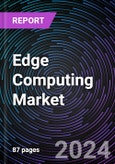10% Free customization
Edge computing is a comprehensive process to enhance cloud computing systems. It specifically refers to the technologies that allow computation to perform at the edge of the network. These services are conducted on downstream data in the place of cloud services and upstream data in place of IoT services. Edge computing also helps in aligning data acquisition and handle functions, storage of high bandwidth content, and applications closer to the end-user. Edge computing also assists in effective data management as data processing, and data filtering can be carryout at the edge of the network, depicting cleaner data sets for cloud-based data analytics. Edge computing market growth is credited to the factors such as drastic usage of internet of things in industries, high demand for low-latency in a computer process, and self-executing decision-making solutions.This report comes with 10% free customization, enabling you to add data that meets your specific business needs.
The scope of the Edge Computing Market is defined in the market analysis as follows:
Based on Components:
- Hardware
- Platform
- Services
Based on Applications:
- Smart Cities
- Location Services
- Analytics
- Environemental Monitoring
- Optimized Local Content
- Data Caching
- Augmented Reality
- Others
- Based on Organization sizes
- Small and Medium-sized Enterprises (SMEs)
- Large Enterprises
Based on Verticals:
- Vertical
- Manufaturing
- Healthcare
- Transportation
- Government
- Media and Entertainment
- Energy and Utilities
- Telecom & IT
- Retail
- Others
Based on Geography:
- North America
- Europe
- Asia Pacific
- Rest of the World
The market by component includes hardware, platform, and services. The hardware component is assumed to take up the major market size in the forecast period, for the reason that the large-scale acquisition of hardware components for decentralizing storage and computing operations, enabling inclusive edge infrastructure deployment, and decreasing network traffic. Organizations provide upgraded edge computing hardware that either work as an initial point of data source or a facilitator of the total network or performs as storage and local processing unit in the overall edge computing procedure. Further, in the edge computing market by application, the smart cities application possesses major share as it augments the security of the buildings in the cities, automatic facilities in the home and enhances the management of the traffic in the smart city to tackle with the heavy traffic in the metro cities.
The acquisition of edge computing solutions in large enterprises is extreme since the growing trend of data, which is accredited to the widely spread geographical existence and regular customers. Moreover, the rising demand of employees to ingress computing solutions and applications everywhere while secure and proper data storage propelling the demand of edge computing solutions in large enterprises. For example, large manufacturing companies required to correspond with ample data from sensors or actuators connected to their physical assets, such as machines, turbines, and lifts with historical information. Therefore, this helps them to identify or estimate failures in a short time to ignore pause time and loss in production.
North America is considered as the largest revenue-generating region in this market. The integration of edge computing with the industrial internet of things (IIoT) has intensified manufacturers in the U.S to move towards connected factories. Additionally, the arrival of various start-ups providing opportunities to develop an edge-enabled solution is pushing the industry growth in this region.
Globally, the Edge Computing Market will grow at a CAGR of 37.5% during the forecast period, with a base value of $4.04 billion in 2020, to $26.62 billion in 2026. The factors pushing this market growth are the increasing usage of ‘internet of things’ in all sectors for the easy flow of work without human-to-human interaction, increasing demand for automatic decision-making solutions, and overcoming the drastic increase in data.
The report also includes the analysis of major players in the Edge Computing market. Some of the major players consist of Cisco, HPE, Huawei, Unit4, Dell Technologies, Microsoft Corporation, NOKIA, IBM, Foghorn Systems, and Machineshop.
Hence, the arrival of automated vehicles and connected car technology enhances the effectiveness of edge computing. This study will assist the major competitors in knowing the significant market tendency, market fluctuations, and potential needs of the end-users.
- This report provides a complete analysis of present factors driving the market, market opportunities, conflicts, and challenges faced by the players.
- Edge computing market's overall analysis based on different segments is presented in this research.
- Edge computing market is analyzed quantitatively which enables the users to understand the market evolution in all four geographical regions
Table of Contents
1. Executive Summary13. Analyst Opinion
2. Industry Outlook
3. Market Snapshot
4. Market Outlook
5. Component: Market Size & Analysis
6. Vertical: Market Size & Analysis
7. Application: Market Size & Analysis
8. Organization Sizes: Market Size & Analysis
9. Geography: Market Size & Analysis
10. Competitive Landscape
11. Vendor Profiles
12. Companies to Watch
14. Annexure
Companies Mentioned
- Cisco
- HPE
- Huawei
- Unit4
- Dell Technologies
- Microsoft Corporation
- NOKIA
- IBM
- Foghorn Systems
- Machineshop








